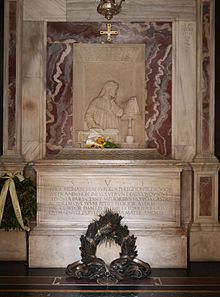The Prophecy of Dante

The Prophecy of Dante – poemat George’a Gordona Byrona. Utwór został napisany w Rawennie w marcu 1819. Jest ułożony tercyną[1], czyli zwrotką trójwersową rymowaną aba bcb cdc...,spopularyzowana przez Dantego Alighieri w Boskiej komedii. Składa się z czterech pieśni. Poemat został napisany dla Teresy Gamby Ghiselli[2].
- From out the mass of never-dying ill,
- The Plague, the Prince, the Stranger, and the Sword,
- Vials of wrath but emptied to refill
- And flow again, I cannot all record
- That crowds on my prophetic eye: the Earth
- And Ocean written o'er would not afford
- Space for the annal, yet it shall go forth;
- Yes, all, though not by human pen, is graven,
- There where the farthest suns and stars have birth,
George Gordon Byron, The Prophecy of Dante
Przypisy
- ↑ Jacek Baluch, Piotr Gierowski: Czesko-polski słownik terminów literackich. Kraków: Wydawnictwo Uniwersytetu Jagiellońskiego, 2016, s. 380. ISBN 978-83-233-4066-9.
- ↑ Poems Written For, To, or Concerning Teresa Guiccioli. petercochran.files.wordpress.com. [dostęp 2017-02-15]. (ang.).
Bibliografia
- George Gordon Byron: The Prophecy of Dante. A Poem. Archive.org, 1821. [dostęp 2017-02-15]. (ang.).
- Beverly Taylor: Byron's Use of Dante in "The Prophecy of Dante". jstor.org. [dostęp 2017-02-15]. (ang.).
- Rosemarie Rowley: Byron's Prophecy of Dante, and its form, terza rima. internationalassociationofbyronsocieties.org. [dostęp 2017-02-15]. (ang.).
Linki zewnętrzne
- George Gordon, Lord Byron: The Works of Lord Byron (ed. Coleridge, Prothero)/Poetry/Volume 4/The Prophecy of Dante. en.wikisource.org. [dostęp 2017-02-15]. (ang.).
